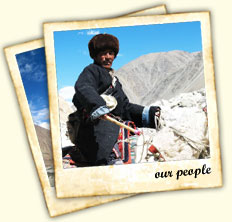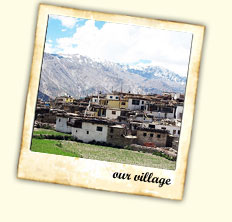Across
the Kashmir Valley and over the Ancient Zoji La pass nestles a
land, ‘Ladakh’, the Land of High Passes. It is a magical land, so
completely different from the green landscape of most other parts of
the inhabitat Himalayas. Ladakh is nature at its extreme. A land of
freezing winds and blazing sunlight, Ladakh is a cold desert lying in
the rain shadow of the Great Himalayas and other smaller ranges. Little
rain and snow reaches this dry area, where the natural forces have
created a fantastic landscape. Ladakh forms a part of the state of
Jammu and Kashmir in India. This region is made up of two
administrative districts namely Leh District, with its headquarters at
Leh, and the Kargil District, with its headquarters at Kargil, and
covers a total area of about 59,000 square kilometers.
Ladakh
is at an average elevation of 2,700 m to 4,200 m above sea level. The
aridity of this region is due to its location in the rain shadow area
of the Great Himalayas, elevation and radiation of heat from the bare
soil. The region is extremely dry, with an annual rainfall as low as
10cubic centimeter. Greenery is a sign of villages.
Few Places of interest in Ladakh
Nubra Valley
The
Nubra Valley means Ldumra (the valley of flowers), situated in the
north of Leh. The average altitude of the valley is about 10,000 ft.
above the sea level. The main attractions in this area are Bactarian
Camels (Shaggy double humped Camel) around the sand dunes, Deskit and
Samstanling monasteries and Khardung la Pass (18,380 ft.) above sea
level. This Tour can be organized for 3 days/2 nights.
Getting There
The
road journey to Nubra valley leads through Khardongla (the highest
motor able road in the world) 18380 ft. around 40 kms away from Leh. On
crossing the pass, you come across Khardong village, Khalsar and Deskit
(the main villages of Nubra valley). Deskit village, Hundar village,
Sumur village and Tirit village offers luxury camps, Guest Houses and
lower budget hotels. The Camel safari can be organized from Deskit to
Hunder village for 2 hours. Hunder village has small monastery and it
is located on the ancient Silk Route.
Chang Thang - The land of Nomads
Changthang means Eastern Flat land, is located in the east of Leh on
the Chinese border. The average altitude of the area is around 14600m
above sea level. This area is also known as Rupsho valley. The main
attraction of this area is Changpa nomads, wild animals, Lakes and rare
migratory birds.
Tomoriri Lake
The
Tsomoriri Lake is a beautiful mountain bounded expanse of water, around
240 Kms from Leh in Rupsho Valley. The Lake is located at 14,000 ft.
near a small village named Korzok. The Nomadic people are most
outstanding feature of this Lake area, which grazed herd of goats and
yaks. The Tsokar (the salt Lake) around 76 kms. from Tsomoriri is also
a beautiful and totally different from the Tsomoriri Lake.
Trip
to these two Lakes can be organized in two or three days by Jeep and
two weeks or three weeks trekking.
Pangong Lake
Pangong
lake is 40 miles in length and nearly 2-4 miles in width at a height of
4267m above the sea level What strikes on seeing this lake is the
lovely color of its water, especially towards evening, which is of the
richest deep blue, over the whole expanse, at morning time, it is of a
lighter a very brilliant color. The water of the Lake is not that salty
as sea water.
Pangong Tso trip can be organized in two days and
overnight stay at simple resorts just beside the Lake. Travellers
are not allowed to pitch their tents near the Lake and only allowed to
go upto Spangmik due to security reasons. As 75% of the Lake is in
China and only 25% is in India. The landscape on the way to Pangong is
spectacular.
The land of Aryans
Dhahanu
is situated to the south west of Leh, around 163 Kms. passing through
the beautiful villages of Kaltsey, Domkhar, Skurbuchan and Achinathang.
There are many small villages but only two villages of Dha and Hanu are
open for tourist. Being on lower altitude Dhahanu is warmer than Leh. Attraction
The
main attraction of this tour is Drokpa Community considered being as
last race of Aryans confined to the valley. Their feature is pure Indo
Aryan and they have preserved their racial purity down the Centuries.
Their culture and religious practices are very similar to ancient pre-
Buddhist religion known as Bon-Chos. This tour can be done in two days.
Temperature
The winter temperature touches as low as minus 30 degree Celsius (Leh
& Kargil) and minus 60 degree Celsius in (Drass). Subzero temp.
prevails from December to February throughout Ladakh, whereas, zero
degree temp. is experienced during rest of the winter months. This
results in freezing of all conceivable water resources. During summers
the maximum temp. increases from 20 degree C to 38 degree C in July and
August
Clothing
Light/Medium woolens in summers to Heavy woolens in winters. Credit Cards & ATM Machine
Credit cards are accepted by few of the hotels and shops at Leh only,
but there will be a nominal service charge. There are five banks that
operate in Leh which are, Jammu and Kashmir Bank, State Bank of India,
HDFC Bank, Axis Bank and Punjab National Bank and all of them have an
ATM Machine each in Leh. |

Ladakh - The Land of High Passes
Area: 98,000sq km
Altitude: 7,500m Max.
Population: 250,000
Religion: Buddhism, Islam and Hinduism
Geographical Status: Cold Mountain Desert
About Leh
Leh
is the headquarter of Ladakh District, and the largest town of the
region. It is located to the north of the Indus River at an elevation
of 3600m above the sea level. The town is marked by the nine-storied
Namgyal Palace and Namgyal Tsemo (victory peak), built by Tashi Namgyal
on his victorious in reunification of the Upper and Lower Ladakh. Leh
became the capital of Stod (upper Ladakh) during the reign of king
Graspa Bum- Lde, who ruled Ladakh from 1400 to 1430 AD. In the later
period, Leh became an important center for trade in Central Asia. Leh
remained merely a headquarter of Ladakh district until 1974, when
Ladakh was opened for foreign tourists. Since then Leh became the
centre, for tourism related activities in the region.
How to Reach
Overland Approach
Srinagar to Leh -
The overland approach to Ladakh from Kashmir Valley via Kargil is
approx. 434 Km, which remains open for traffic from early June to
November. The most dramatic part of this road journey is the ascent up
the 11,500 feet / 3,505 m high Zoji-La, the pass in the Great Himalayan
Wall that serves as the gateway to Ladakh. The J & K State Road
Transport Corporation (J&K SRTC) operates regular Deluxe and
Ordinary bus services between Srinagar and Leh on this route with an
overnight halt at Kargil. Taxis are also available at Srinagar for the
journey. Groups can charter Deluxe and A-class buses for Leh, Kargil or
Padum (Zangskar) from the J & K SRTC at Srinagar.
Manali to Leh -
Since 1989, the 473 km. Manali-Leh road has been serving as the second
overland approach to Ladakh. Open for traffic from around mid-June to
early October. This high road traverses the upland desert plateau of
Rupsho, altitude ranges from 3,660m to 4,570m. A number of high passes
are crossed before reaching Leh, among which the highest one known as
TaklangLa is the world's second highest motorable pass at an altitude
of 17,469 ft/5,235m. Shared taxis are also available both from Leh and
Manali.
The drive from
Manali leads you to the most historical pass of Himachal Pradesh,
the Rohtang Pass(3980 m). The landscape surprisingly changes into the
rugged brown of the rain shadow area of Lahaul. The landscape changes
into naked desert after crossing a few villages of Lahul with prayer
flags on their roofs.Your journey finishes at Leh making it a drive of
lifetime’s experience.
Road Distances
- Srinagar-Leh 434 Km
- Manali-Leh 473 Km
- Srinagar-Kargil 204 Km
- Delhi-Leh 1047 Kms
- Leh-Kargil 234 Km
- Kargil-Padum (Zanskar) 240 Km
- Leh-Deskit (Nubra Valley)118 Kms.
Air Travel
Air India www.airindia.in/ operates regular flights to Leh from Delhi and four times a week from Jammu and thrice a week from Srinagar. Jet Airways www.jetairways.com
operates regular flights to Leh from Delhi and five times a week from
Chandigarh and Jammu and four times a week from Srinagar. Go Air www.goair.in/ operates regular flights to Leh from Delhi.
Languages Spoken
Ladakhi is the main language of Ladakh. Other languages spoken are
Balti, Shina, Brokshat and Changshat. In hotels and restaurants, staffs
speak English and Hindi, while tourist guides are well versed with the
languages. Permit and Passport
Tourist don't require permit for Leh, however, all foreigners are
required to be registered at Drass, Rumtse and Serchu if they are
travelling overland. Those traveling by air get themselves registered
at airport. Tourists are required to get permit for restricted areas
like Tsomoriri, Tsokar and Pangong Lakes, Dhahanu and Nubra Valley,
which can be obtained from District Magistrate, Leh. We can also
arrange that for you.

|